window DODGE DURANGO 2011 3.G User Guide
[x] Cancel search | Manufacturer: DODGE, Model Year: 2011, Model line: DURANGO, Model: DODGE DURANGO 2011 3.GPages: 108, PDF Size: 5.96 MB
Page 10 of 108
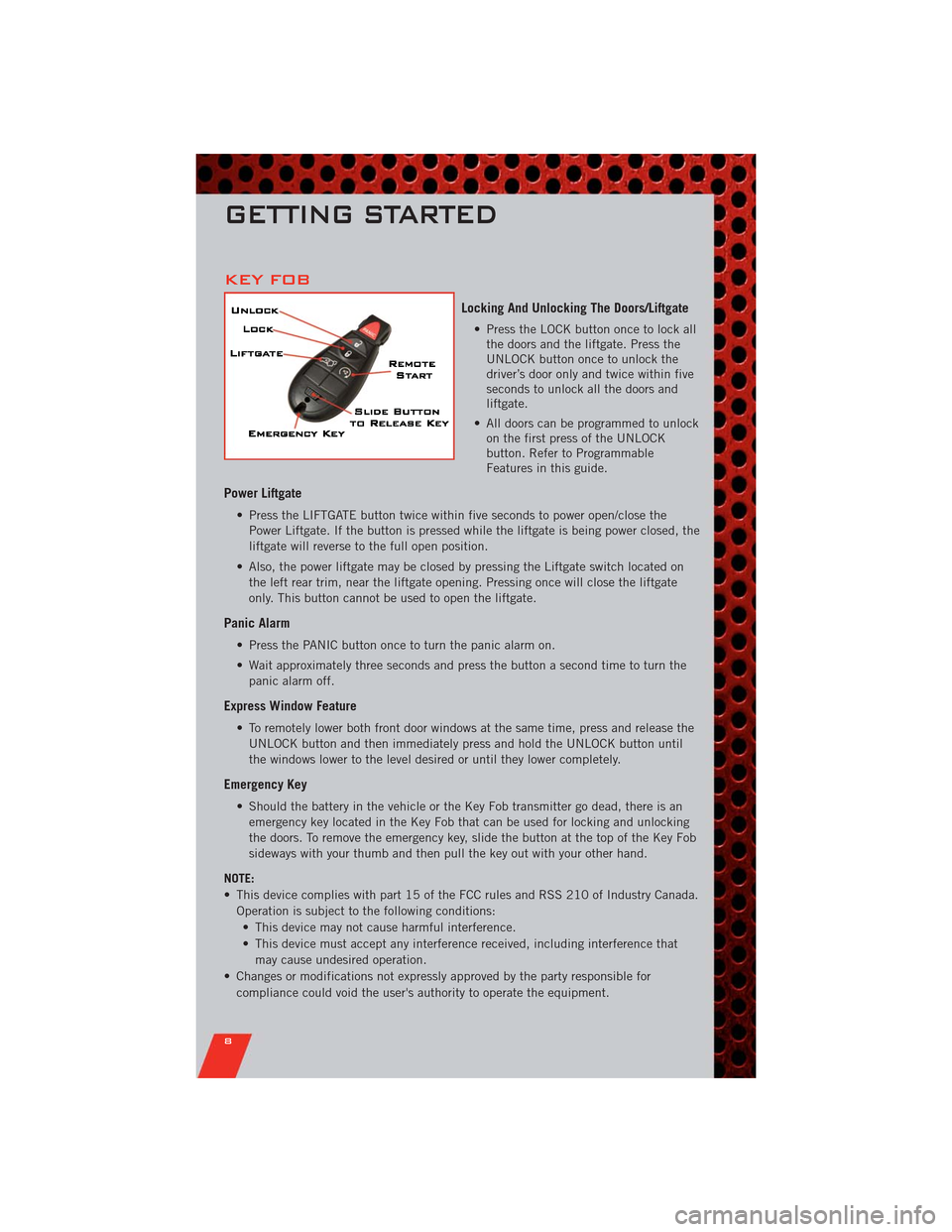
KEY FOB
Locking And Unlocking The Doors/Liftgate
• Press the LOCK button once to lock all
the doors and the liftgate. Press the
UNLOCK button once to unlock the
driver’s door only and twice within five
seconds to unlock all the doors and
liftgate.
• All doors can be programmed to unlock
on the first press of the UNLOCK
button. Refer to Programmable
Features in this guide.
Power Liftgate
• Press the LIFTGATE button twice within five seconds to power open/close the
Power Liftgate. If the button is pressed while the liftgate is being power closed, the
liftgate will reverse to the full open position.
• Also, the power liftgate may be closed by pressing the Liftgate switch located on
the left rear trim, near the liftgate opening. Pressing once will close the liftgate
only. This button cannot be used to open the liftgate.
Panic Alarm
• Press the PANIC button once to turn the panic alarm on.
• Wait approximately three seconds and press the button a second time to turn the
panic alarm off.
Express Window Feature
• To remotely lower both front door windows at the same time, press and release the
UNLOCK button and then immediately press and hold the UNLOCK button until
the windows lower to the level desired or until they lower completely.
Emergency Key
• Should the battery in the vehicle or the Key Fob transmitter go dead, there is an
emergency key located in the Key Fob that can be used for locking and unlocking
the doors. To remove the emergency key, slide the button at the top of the Key Fob
sideways with your thumb and then pull the key out with your other hand.
NOTE:
• This device complies with part 15 of the FCC rules and RSS 210 of Industry Canada.
Operation is subject to the following conditions:
• This device may not cause harmful interference.
• This device must accept any interference received, including interference that
may cause undesired operation.
• Changes or modifications not expressly approved by the party responsible for
compliance could void the user's authority to operate the equipment.
GETTING STARTED
8
Page 11 of 108
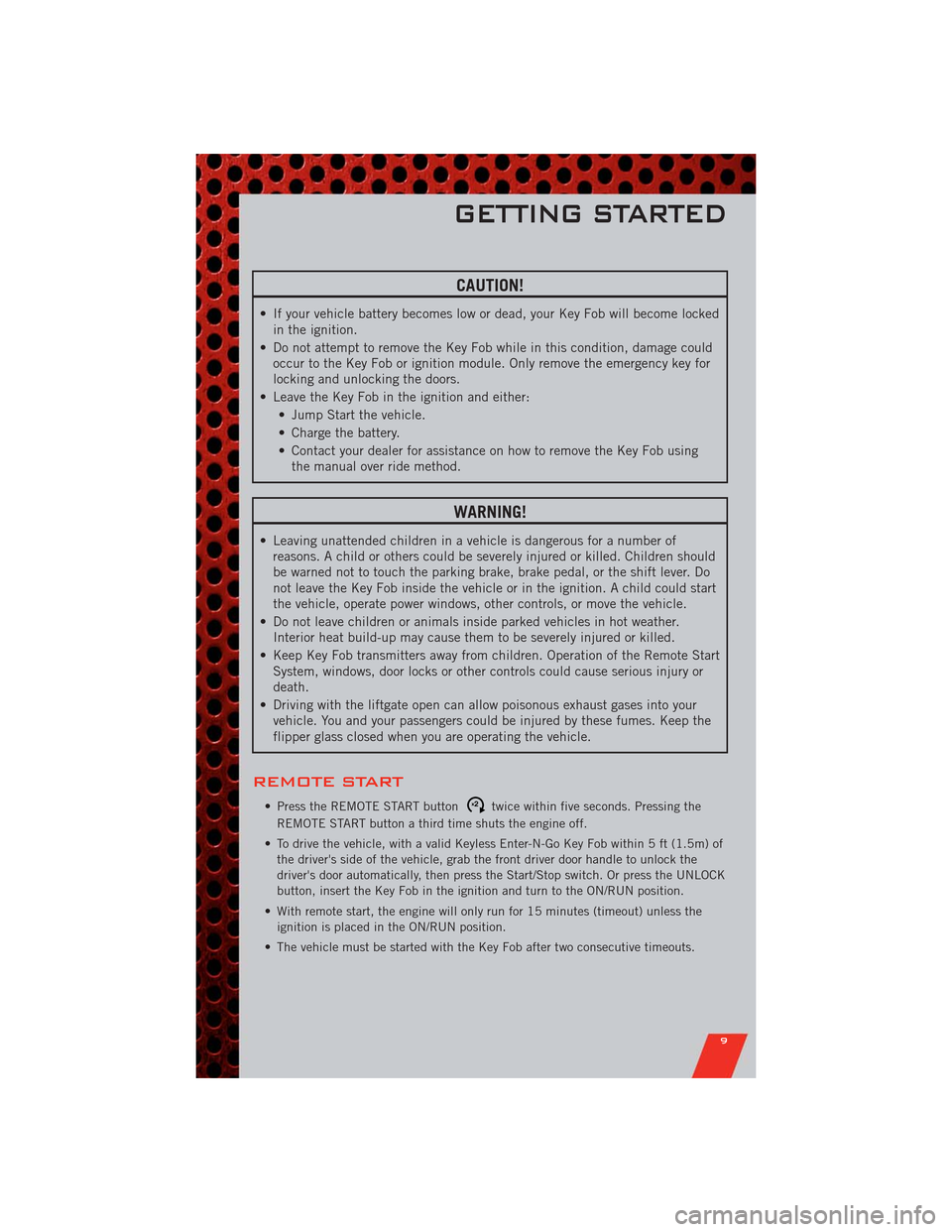
CAUTION!
• If your vehicle battery becomes low or dead, your Key Fob will become locked
in the ignition.
• Do not attempt to remove the Key Fob while in this condition, damage could
occur to the Key Fob or ignition module. Only remove the emergency key for
locking and unlocking the doors.
• Leave the Key Fob in the ignition and either:
• Jump Start the vehicle.
• Charge the battery.
• Contact your dealer for assistance on how to remove the Key Fob using
the manual over ride method.
WARNING!
• Leaving unattended children in a vehicle is dangerous for a number of
reasons. A child or others could be severely injured or killed. Children should
be warned not to touch the parking brake, brake pedal, or the shift lever. Do
not leave the Key Fob inside the vehicle or in the ignition. A child could start
the vehicle, operate power windows, other controls, or move the vehicle.
• Do not leave children or animals inside parked vehicles in hot weather.
Interior heat build-up may cause them to be severely injured or killed.
• Keep Key Fob transmitters away from children. Operation of the Remote Start
System, windows, door locks or other controls could cause serious injury or
death.
• Driving with the liftgate open can allow poisonous exhaust gases into your
vehicle. You and your passengers could be injured by these fumes. Keep the
flipper glass closed when you are operating the vehicle.
REMOTE START
• Press the REMOTE START buttonx2twice within five seconds. Pressing the
REMOTE START button a third time shuts the engine off.
• To drive the vehicle, with a valid Keyless Enter-N-Go Key Fob within 5 ft (1.5m) of
the driver's side of the vehicle, grab the front driver door handle to unlock the
driver's door automatically, then press the Start/Stop switch. Or press the UNLOCK
button, insert the Key Fob in the ignition and turn to the ON/RUN position.
• With remote start, the engine will only run for 15 minutes (timeout) unless the
ignition is placed in the ON/RUN position.
• The vehicle must be started with the Key Fob after two consecutive timeouts.
GETTING STARTED
9
Page 12 of 108
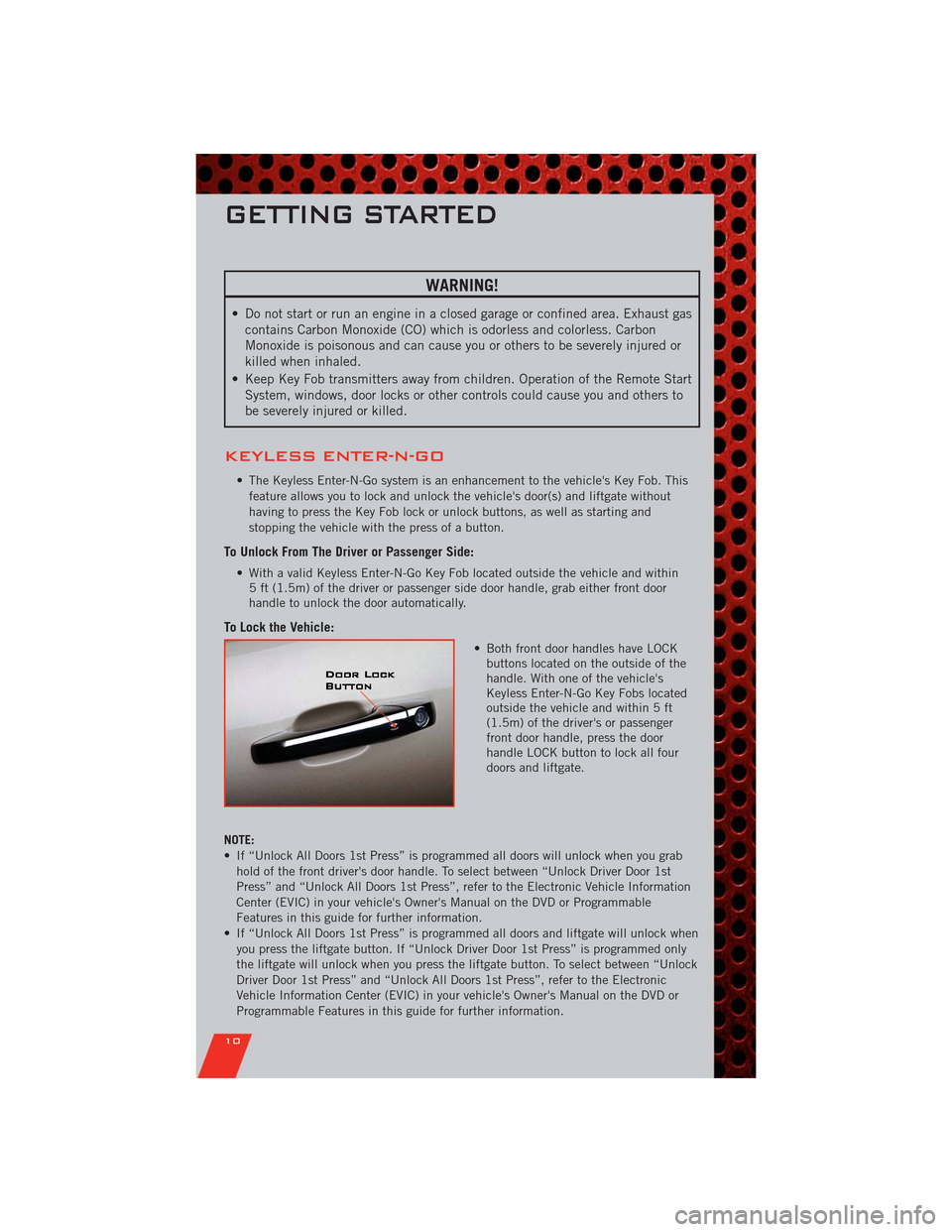
WARNING!
• Do not start or run an engine in a closed garage or confined area. Exhaust gas
contains Carbon Monoxide (CO) which is odorless and colorless. Carbon
Monoxide is poisonous and can cause you or others to be severely injured or
killed when inhaled.
• Keep Key Fob transmitters away from children. Operation of the Remote Start
System, windows, door locks or other controls could cause you and others to
be severely injured or killed.
KEYLESS ENTER-N-GO
• The Keyless Enter-N-Go system is an enhancement to the vehicle's Key Fob. This
feature allows you to lock and unlock the vehicle's door(s) and liftgate without
having to press the Key Fob lock or unlock buttons, as well as starting and
stopping the vehicle with the press of a button.
To Unlock From The Driver or Passenger Side:
• With a valid Keyless Enter-N-Go Key Fob located outside the vehicle and within
5 ft (1.5m) of the driver or passenger side door handle, grab either front door
handle to unlock the door automatically.
To Lock the Vehicle:
• Both front door handles have LOCK
buttons located on the outside of the
handle. With one of the vehicle's
Keyless Enter-N-Go Key Fobs located
outside the vehicle and within 5 ft
(1.5m) of the driver's or passenger
front door handle, press the door
handle LOCK button to lock all four
doors and liftgate.
NOTE:
• If “Unlock All Doors 1st Press” is programmed all doors will unlock when you grab
hold of the front driver's door handle. To select between “Unlock Driver Door 1st
Press” and “Unlock All Doors 1st Press”, refer to the Electronic Vehicle Information
Center (EVIC) in your vehicle's Owner's Manual on the DVD or Programmable
Features in this guide for further information.
• If “Unlock All Doors 1st Press” is programmed all doors and liftgate will unlock when
you press the liftgate button. If “Unlock Driver Door 1st Press” is programmed only
the liftgate will unlock when you press the liftgate button. To select between “Unlock
Driver Door 1st Press” and “Unlock All Doors 1st Press”, refer to the Electronic
Vehicle Information Center (EVIC) in your vehicle's Owner's Manual on the DVD or
Programmable Features in this guide for further information.
GETTING STARTED
10
Page 15 of 108
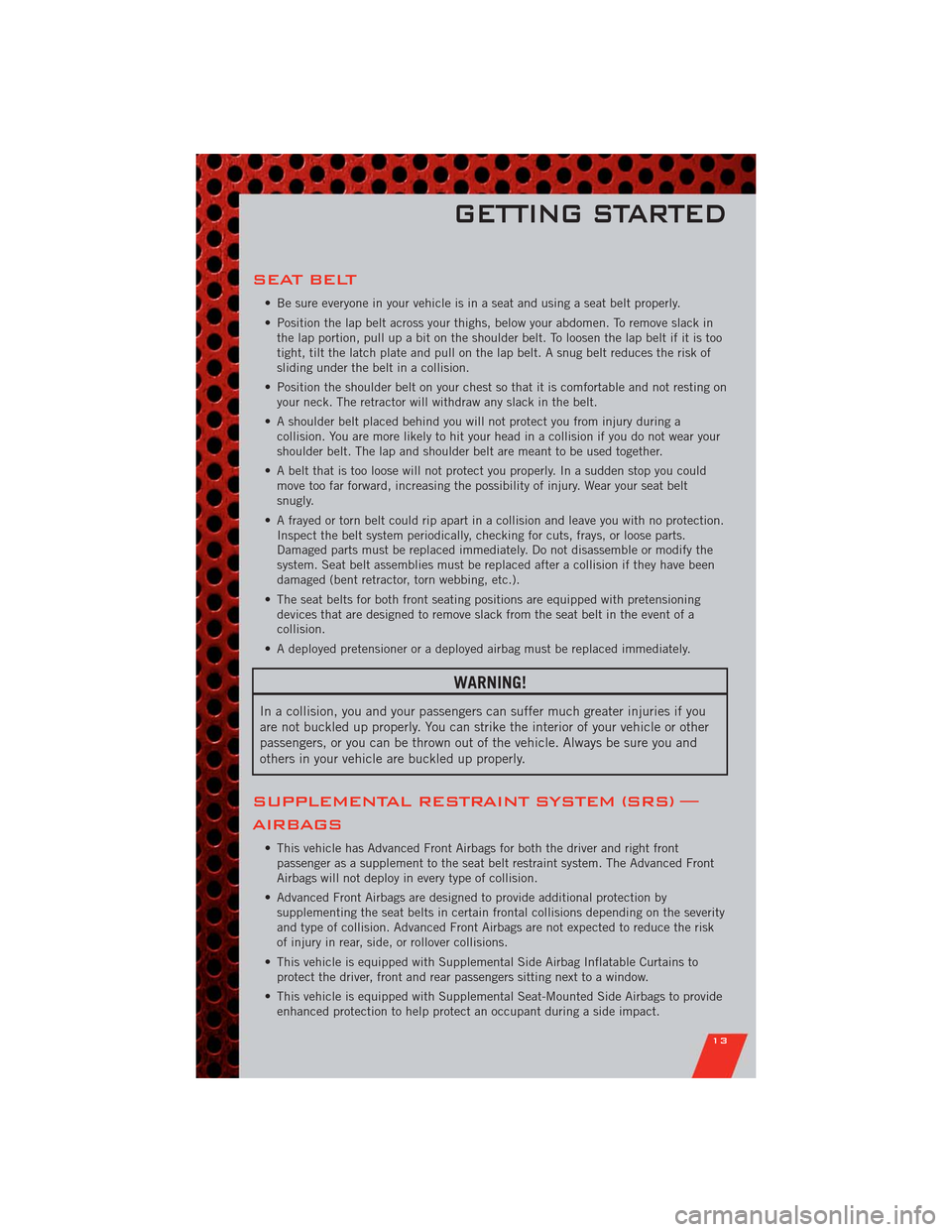
SEAT BELT
• Be sure everyone in your vehicle is in a seat and using a seat belt properly.
• Position the lap belt across your thighs, below your abdomen. To remove slack in
the lap portion, pull up a bit on the shoulder belt. To loosen the lap belt if it is too
tight, tilt the latch plate and pull on the lap belt. A snug belt reduces the risk of
sliding under the belt in a collision.
• Position the shoulder belt on your chest so that it is comfortable and not resting on
your neck. The retractor will withdraw any slack in the belt.
• A shoulder belt placed behind you will not protect you from injury during a
collision. You are more likely to hit your head in a collision if you do not wear your
shoulder belt. The lap and shoulder belt are meant to be used together.
• A belt that is too loose will not protect you properly. In a sudden stop you could
move too far forward, increasing the possibility of injury. Wear your seat belt
snugly.
• A frayed or torn belt could rip apart in a collision and leave you with no protection.
Inspect the belt system periodically, checking for cuts, frays, or loose parts.
Damaged parts must be replaced immediately. Do not disassemble or modify the
system. Seat belt assemblies must be replaced after a collision if they have been
damaged (bent retractor, torn webbing, etc.).
• The seat belts for both front seating positions are equipped with pretensioning
devices that are designed to remove slack from the seat belt in the event of a
collision.
• A deployed pretensioner or a deployed airbag must be replaced immediately.
WARNING!
In a collision, you and your passengers can suffer much greater injuries if you
are not buckled up properly. You can strike the interior of your vehicle or other
passengers, or you can be thrown out of the vehicle. Always be sure you and
others in your vehicle are buckled up properly.
SUPPLEMENTAL RESTRAINT SYSTEM (SRS) —
AIRBAGS
• This vehicle has Advanced Front Airbags for both the driver and right front
passenger as a supplement to the seat belt restraint system. The Advanced Front
Airbags will not deploy in every type of collision.
• Advanced Front Airbags are designed to provide additional protection by
supplementing the seat belts in certain frontal collisions depending on the severity
and type of collision. Advanced Front Airbags are not expected to reduce the risk
of injury in rear, side, or rollover collisions.
• This vehicle is equipped with Supplemental Side Airbag Inflatable Curtains to
protect the driver, front and rear passengers sitting next to a window.
• This vehicle is equipped with Supplemental Seat-Mounted Side Airbags to provide
enhanced protection to help protect an occupant during a side impact.
GETTING STARTED
13
Page 16 of 108
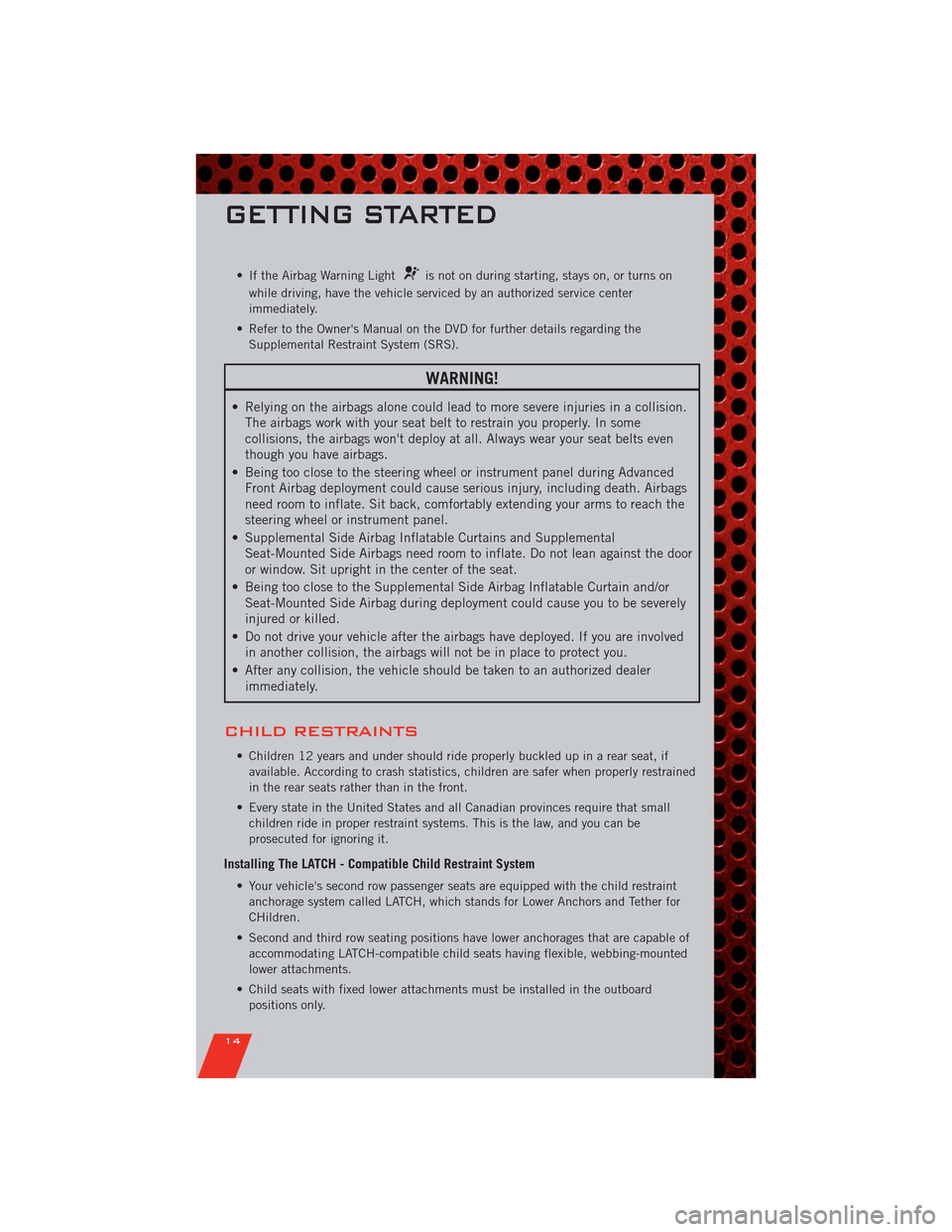
• If the Airbag Warning Lightis not on during starting, stays on, or turns on
while driving, have the vehicle serviced by an authorized service center
immediately.
• Refer to the Owner's Manual on the DVD for further details regarding the
Supplemental Restraint System (SRS).
WARNING!
• Relying on the airbags alone could lead to more severe injuries in a collision.
The airbags work with your seat belt to restrain you properly. In some
collisions, the airbags won't deploy at all. Always wear your seat belts even
though you have airbags.
• Being too close to the steering wheel or instrument panel during Advanced
Front Airbag deployment could cause serious injury, including death. Airbags
need room to inflate. Sit back, comfortably extending your arms to reach the
steering wheel or instrument panel.
• Supplemental Side Airbag Inflatable Curtains and Supplemental
Seat-Mounted Side Airbags need room to inflate. Do not lean against the door
or window. Sit upright in the center of the seat.
• Being too close to the Supplemental Side Airbag Inflatable Curtain and/or
Seat-Mounted Side Airbag during deployment could cause you to be severely
injured or killed.
• Do not drive your vehicle after the airbags have deployed. If you are involved
in another collision, the airbags will not be in place to protect you.
• After any collision, the vehicle should be taken to an authorized dealer
immediately.
CHILD RESTRAINTS
• Children 12 years and under should ride properly buckled up in a rear seat, if
available. According to crash statistics, children are safer when properly restrained
in the rear seats rather than in the front.
• Every state in the United States and all Canadian provinces require that small
children ride in proper restraint systems. This is the law, and you can be
prosecuted for ignoring it.
Installing The LATCH - Compatible Child Restraint System
• Your vehicle's second row passenger seats are equipped with the child restraint
anchorage system called LATCH, which stands for Lower Anchors and Tether for
CHildren.
• Second and third row seating positions have lower anchorages that are capable of
accommodating LATCH-compatible child seats having flexible, webbing-mounted
lower attachments.
• Child seats with fixed lower attachments must be installed in the outboard
positions only.
GETTING STARTED
14
Page 32 of 108
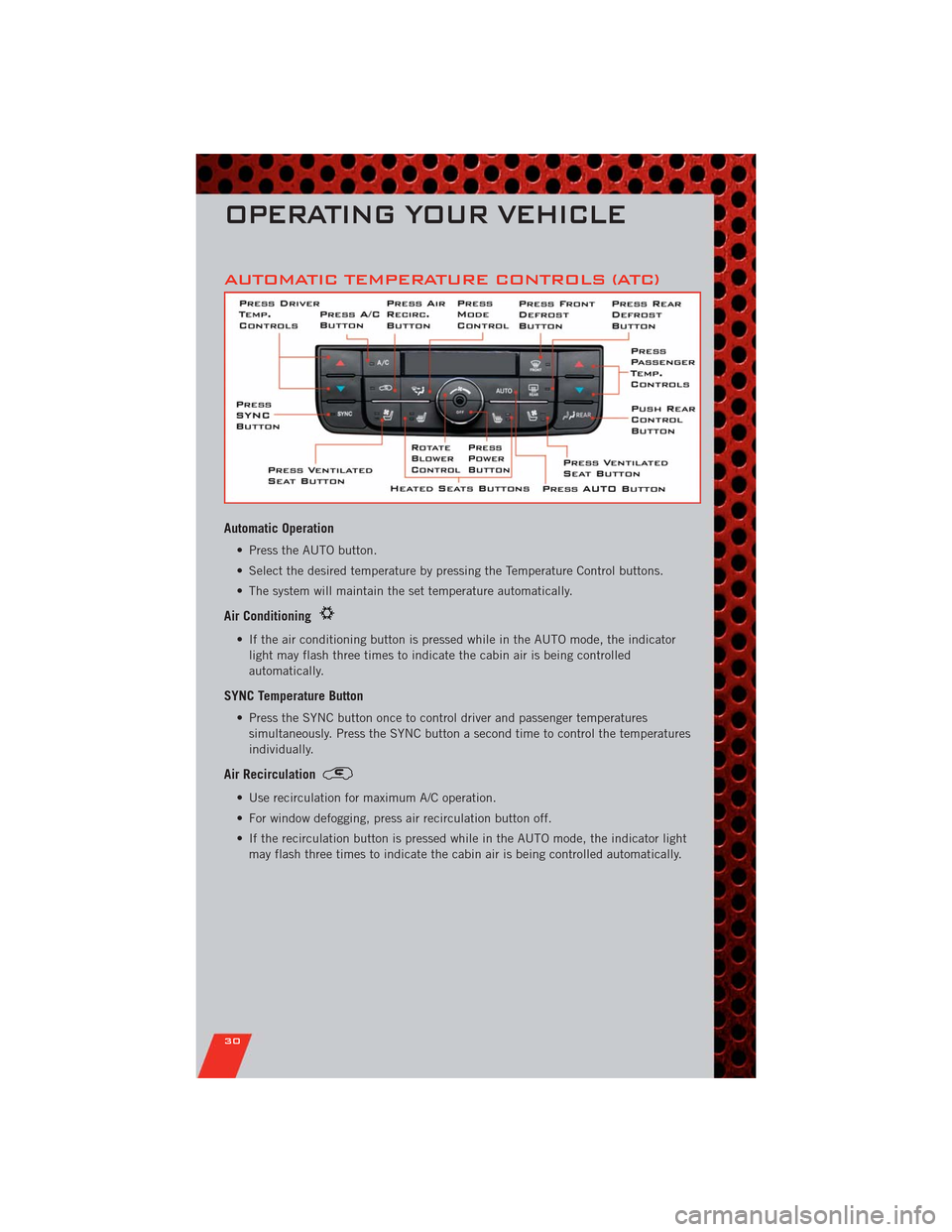
AUTOMATIC TEMPERATURE CONTROLS (ATC)
Automatic Operation
• Press the AUTO button.
• Select the desired temperature by pressing the Temperature Control buttons.
• The system will maintain the set temperature automatically.
Air Conditioning
• If the air conditioning button is pressed while in the AUTO mode, the indicator
light may flash three times to indicate the cabin air is being controlled
automatically.
SYNC Temperature Button
• Press the SYNC button once to control driver and passenger temperatures
simultaneously. Press the SYNC button a second time to control the temperatures
individually.
Air Recirculation
• Use recirculation for maximum A/C operation.
• For window defogging, press air recirculation button off.
• If the recirculation button is pressed while in the AUTO mode, the indicator light
may flash three times to indicate the cabin air is being controlled automatically.
OPERATING YOUR VEHICLE
30
Page 37 of 108
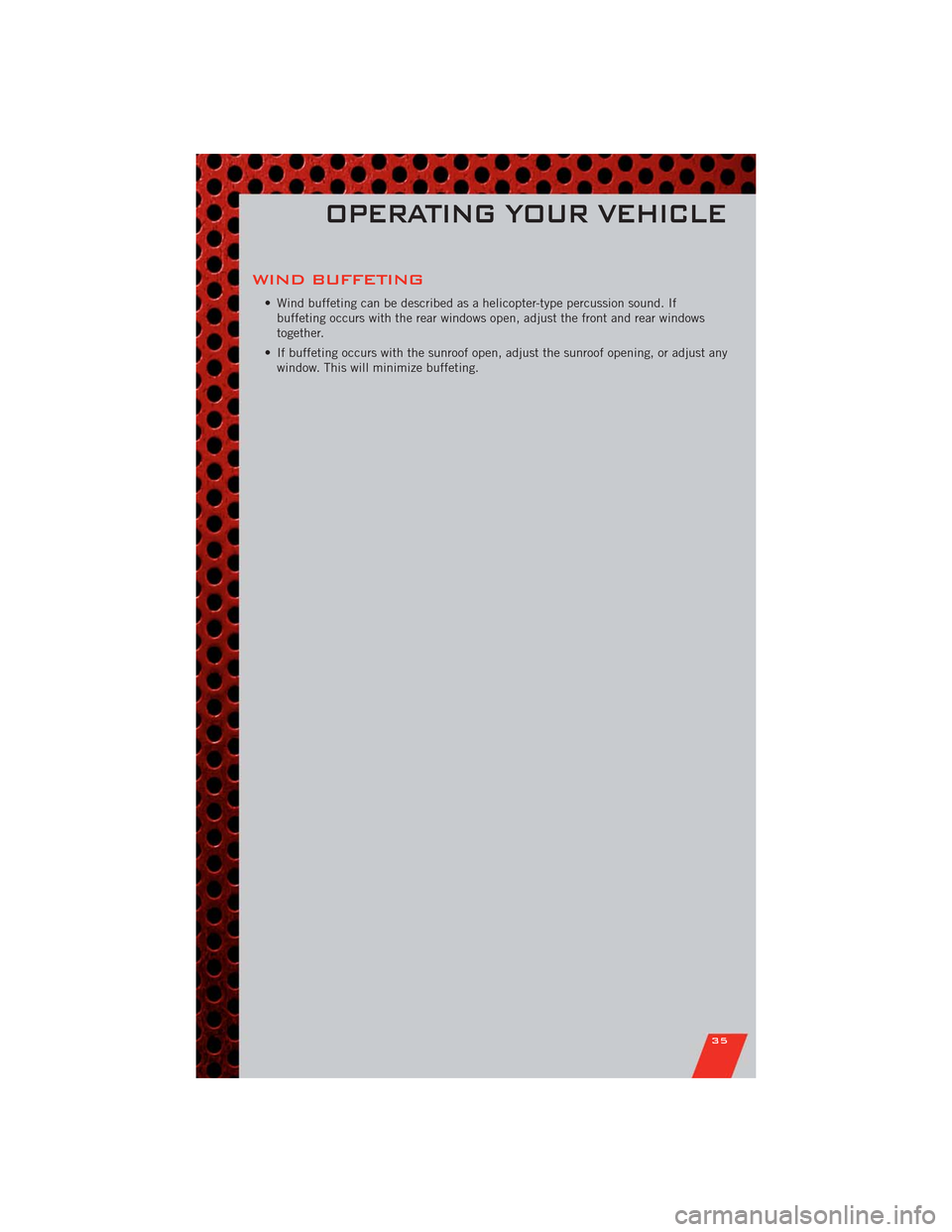
WIND BUFFETING
• Wind buffeting can be described as a helicopter-type percussion sound. If
buffeting occurs with the rear windows open, adjust the front and rear windows
together.
• If buffeting occurs with the sunroof open, adjust the sunroof opening, or adjust any
window. This will minimize buffeting.
OPERATING YOUR VEHICLE
35
Page 97 of 108
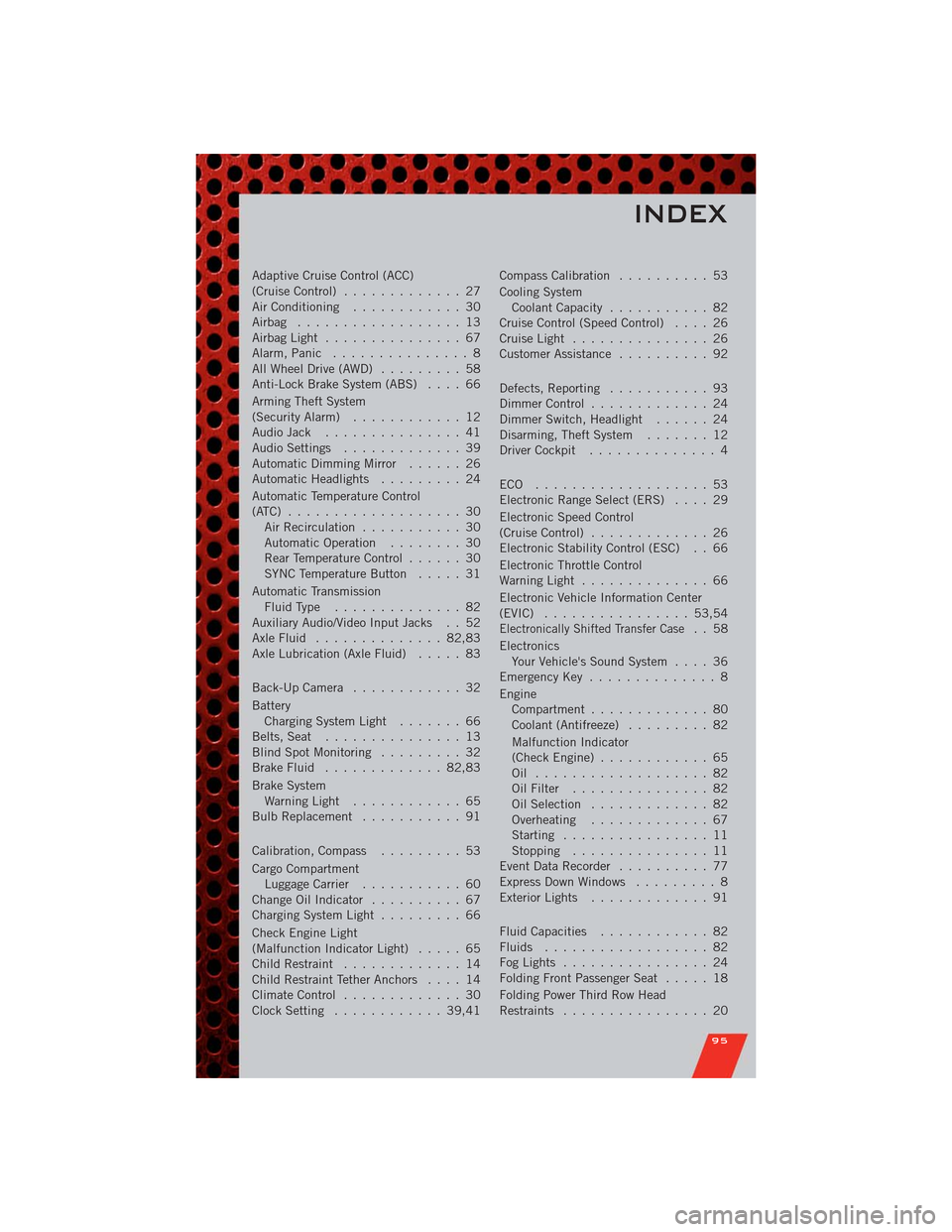
Adaptive Cruise Control (ACC)
(Cruise Control)............. 27
Air Conditioning............ 30
Airbag .................. 13
AirbagLight ............... 67
Alarm,Panic ............... 8
All Wheel Drive (AWD)......... 58
Anti-Lock Brake System (ABS).... 66
Arming Theft System
(Security Alarm)............ 12
Audio Jack............... 41
Audio Settings............. 39
Automatic Dimming Mirror...... 26
Automatic Headlights......... 24
Automatic Temperature Control
(ATC) ................... 30
Air Recirculation........... 30
Automatic Operation........ 30
Rear Temperature Control...... 30
SYNC Temperature Button..... 31
Automatic Transmission
FluidType .............. 82
Auxiliary Audio/Video Input Jacks . . 52
AxleFluid .............. 82,83
Axle Lubrication (Axle Fluid)..... 83
Back-Up Camera............ 32
Battery
Charging System Light....... 66
Belts, Seat............... 13
Blind Spot Monitoring......... 32
Brake Fluid............. 82,83
Brake System
WarningLight ............ 65
BulbReplacement ........... 91
Calibration,Compass ......... 53
Cargo Compartment
Luggage Carrier........... 60
ChangeOilIndicator .......... 67
Charging System Light......... 66
Check Engine Light
(Malfunction Indicator Light)..... 65
Child Restraint............. 14
Child Restraint Tether Anchors.... 14
Climate Control............. 30
Clock Setting............ 39,41Compass Calibration.......... 53
Cooling System
Coolant Capacity........... 82
Cruise Control (Speed Control).... 26
CruiseLight ............... 26
Customer Assistance.......... 92
Defects, Reporting........... 93
Dimmer Control............. 24
Dimmer Switch, Headlight...... 24
Disarming, Theft System....... 12
Driver Cockpit.............. 4
ECO ................... 53
Electronic Range Select (ERS).... 29
Electronic Speed Control
(Cruise Control)............. 26
Electronic Stability Control (ESC) . . 66
Electronic Throttle Control
WarningLight .............. 66
Electronic Vehicle Information Center
(EVIC) ................ 53,54
Electronically Shifted Transfer Case.. 58
Electronics
Your Vehicle's Sound System.... 36
Emergency Key.............. 8
Engine
Compartment............. 80
Coolant (Antifreeze)......... 82
Malfunction Indicator
(CheckEngine) ............ 65
Oil ................... 82
Oil Filter............... 82
Oil Selection............. 82
Overheating............. 67
Starting................ 11
Stopping ............... 11
Event Data Recorder.......... 77
Express Down Windows......... 8
Exterior Lights............. 91
Fluid Capacities............ 82
Fluids .................. 82
FogLights ................ 24
Folding Front Passenger Seat..... 18
Folding Power Third Row Head
Restraints................ 20
INDEX
95
Page 100 of 108
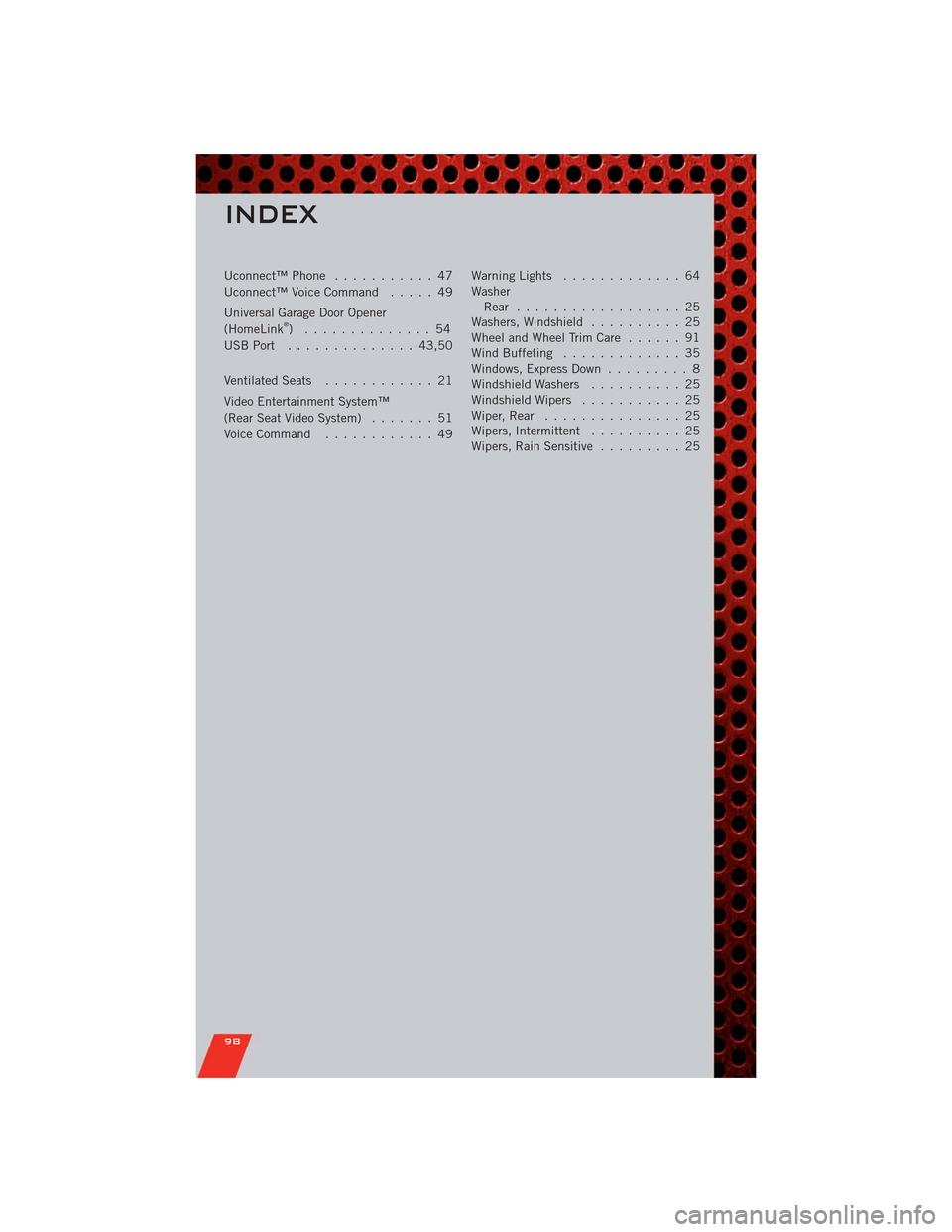
Uconnect™ Phone........... 47
Uconnect™ Voice Command..... 49
Universal Garage Door Opener
(HomeLink
®) .............. 54
USBPort .............. 43,50
Ventilated Seats............ 21
Video Entertainment System™
(Rear Seat Video System)....... 51
Voice Command............ 49WarningLights ............. 64
Washer
Rear .................. 25
Washers, Windshield.......... 25
Wheel and Wheel Trim Care...... 91
Wind Buffeting............. 35
Windows, Express Down......... 8
Windshield Washers.......... 25
Windshield Wipers........... 25
Wiper,Rear ............... 25
Wipers, Intermittent.......... 25
Wipers, Rain Sensitive......... 25
INDEX
98